With the advancement of computers and the internet, we don’t
need to look at the television screen or newspaper for weather
updates. Rather, we can just pick our phone and get to know the
current weather. Even if we are working on our Linux desktop, we
can get notified about the forecastings. Thanks to the weather
tools for Linux.
Most of the modern Linux distributions[1] come with a default
weather app. Yet some distros lack this feature by default. These
weather tools can show you a plethora of weather parameters by
using the API keys of third-party weather info providers. You just
need an internet connection, and you are good to go. Now you don’t
need to worry about whether you should take the umbrella with you
while going out.
Just like other popular computer operating systems, Linux has a
great library of weather tools. Most of them are open-source and
free to use. Since you don’t need more than one weather tool, you
have to choose that one software carefully.
There are different types of weather tools with different user
interfaces and features. The one I like may not be suitable for
you. Hence, we have tested out 10 best weather tools for Linux. I
hope that one of these tools can be your next pick as a weather
forecasting tool.
1. WeeWX
WeeWX is not just a desktop weather app. It is your complete
home weather station. This is a Python-based for fetching weather
data from your weather hardware. It is very easy to use weather
station devices available in the market. This software supports
many types of hardware.
This is the best method of getting the most accurate weather
forecasting for your backyard. No matter whether you are a
geologist or not, you can use this tool for getting required
weather information. This tool can connect to a server and publish
the weather reports for public usage.
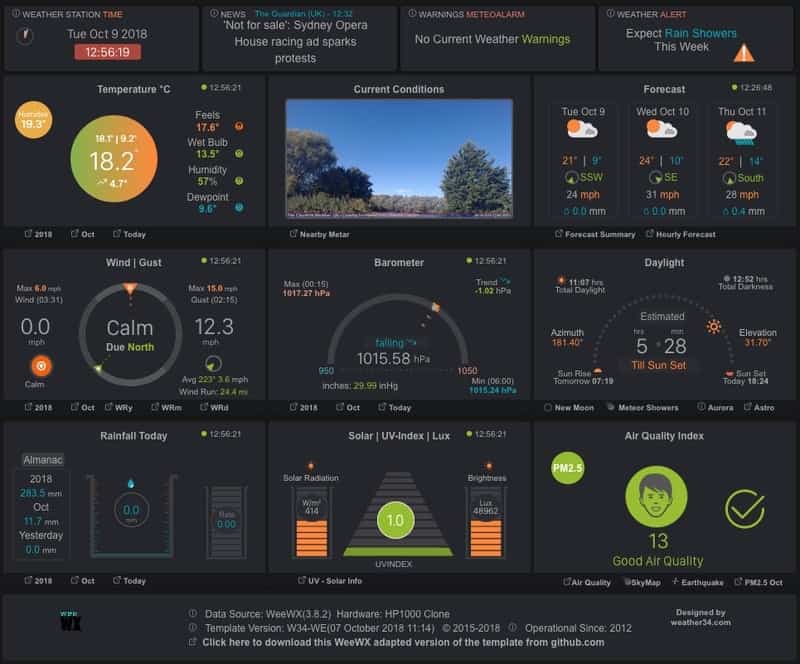
Key Features of WeeWX
- It supports different types of skins for changing the look and
feel. - This tool supports a wide range of models from different
manufacturers including, Davis, Oregon Scientific, RainWise,
etc. - WeeWX can publish data to any third party services such as
OpenWeather, WeatherBug, Weather Cloud, etc. - It can generate graphs and export them as PDF, HTML, and a
variety of file formats. - The dashboard is nicely arranged, and it is completely
customizable according to your needs.
2. Meteo
Meteo-Qt is an excellent open-source weather application for
your Linux desktop. It has all the basic and necessary features
built-in with this too. The graphical UI is very clean. The overall
experience it provides is very smooth. It can display weather
information through desktop notifications.
This tool is built with Python programming language. The
developer used the Qt-5 framework for creating this beautiful user
interface. This tool can integrate with third-party weather
forecasting services via API access. [3]
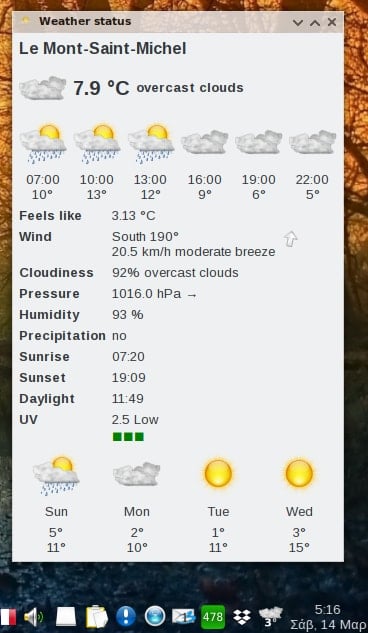
Key Features of Meteo
- This tool can automatically detect your current location and
set that up. - You can choose the best-suited temperature unit based on your
region and preference. - Meteo can show different weather parameters, such as pressure,
humidity, precipitation, wind speed, UV ray, etc. - You can customize the visual appearance, fonts, icons, and some
other things. - This tool supports the OpenWeather for syncing with their
server.
3. Cumulus
Stormcloud was a very popular weather tool for Linux. Although
currently, it is an abandoned project. Some very enthusiastic
developers created this Cumulus based on a fork of Stormcloud. It
comes with all the classic stormcloud vibes with some additional
features.
This tool uses weather API for getting weather forecasts from
the internet. The developers are currently trying hard to port this
tool to the Qt framework. You can download the installer package as
well as the source binary for compilation.
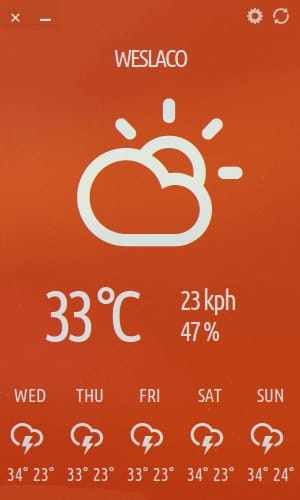
Key Features of Cumulus
- Users can access the forecast using the always-on tray
icon. - It depends on Yahoo Weather and OpenWeather for forecasting
data. - This tool supports a variety of units for temperature and other
weather parameters. - The user interface follows a flat design language, which is
pretty neat. - Being simple, this tool doesn’t give additional stress to the
system.
4. My Weather
Indicator
My weather indicator is a nifty little app for displaying
weather information. It features a bunch of weather parameters.
There is a beautiful desktop weather widget that highlights the
current weather condition along with the location.
It can even show the weather conditions in different nearby
cities using the map. My Weather Indicator can show a detailed
weather report for the next 5 days. This is very convenient if you
want to get the forecasting for an upcoming event.
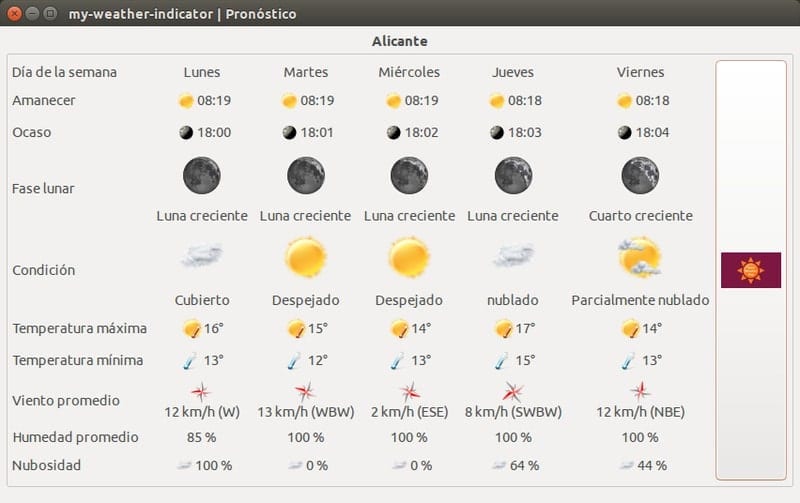
Key Features of My Weather
Indicator
- You can customize the desktop weather widget on your own.
- Users can choose from a variety of services, including Yahoo
Weather, World Weather, Open Weather, etc. - It can show accurate data of sunrise and sundown.
- You can see a detailed report by a single click on the tray
icon. - It can show the weather forecast for two cities
simultaneously.
5. OpenWeather
Extension
This weather tool for Linux is distributed as an extension for
the GNOME desktop environment. It integrates nicely with the
GNOME shell[7]. Although, you can have
this tool only on the GNOME desktop. Most people won’t miss
anything because GNOME is the most preferred DE for many users.
As it is integrated with the system, you just need to click once
to get the detailed weather analytics. Besides, the system tray
icon is dynamic, which can show the current temperature and weather
conditions. As the name suggests, this tool uses the Openweather
API for getting weather info.
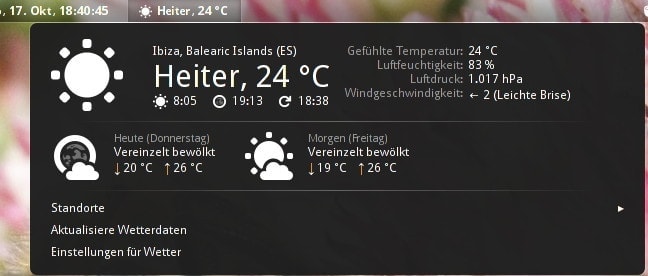
Key Features of OpenWeather
Extension
- This tool can automatically inherit the current co-ordinates
from the system. - You can customize the formatting of the weather units.
- It can show many weather parameters other than temperature,
such as wind, humidity, sunrise, sunset, etc. - The recent version offers DarkSky.net as a forecasting service
along with OpenWeather. - This tool can fetch future forecasts for up to 10 consecutive
days.
6. Temps
This one is my personal favorite. Because I am that kind of guy
who always craves for aesthetics. This is probably the most
beautiful and modern looking weather app out there. The developer
used a good sense of art while designing the user interface.
Not only that, but this tool also has some very useful features.
For example, unit customization and time format customization will
come handy for many users. Besides, you can set this tool to start
up with the operating system so that it stays just a click
away.

Key Features of Temps
- The user interface is very neat and easy to use.
- This tool can generate a line graph based on hourly
temperature. - Temps show subtle animations based on the weather condition
that blends nicely with the app. - You can get future forecasts for the next 4 days accurately
from this tool. - Users can set up to two different locations for the
report.
7. Coffee
This is not only a weather app but also a newsfeed. Because
there is a news crawler built-in with this tool. It can show the
latest news from different sources right after the weather
information. This feature makes it stand out from the crowd of
other weather apps.
The user interface of this tool is very simple. But it provides
some powerful tweaks for weather forecasts. It shows relevant icons
along with the large text information so that you can get the
information by taking a glance.

Key Features of Coffee
- It uses DarkSky weather service for fetching the
forecasts. - Future forecasts are fetched by this tool for up to 5
days. - It can show the weather summary of the current day.
- This tool can detect the location automatically from the system
info. - The news provided in this tool is relevant to your
interest.
8. WeGo
WeGo is not a traditional graphical user interface. It shows the
weather info in a different way. This tool uses the powerful
terminal window of the Linux system for sowing the current weather
info. Pretty cool, right?
Since this tool runs on the terminal, it doesn’t use excessive
system resources. The user interface is ASCII based. Hence, this
tool formats and arranges the report in the ASCII encoding along
with some emojis and icons.
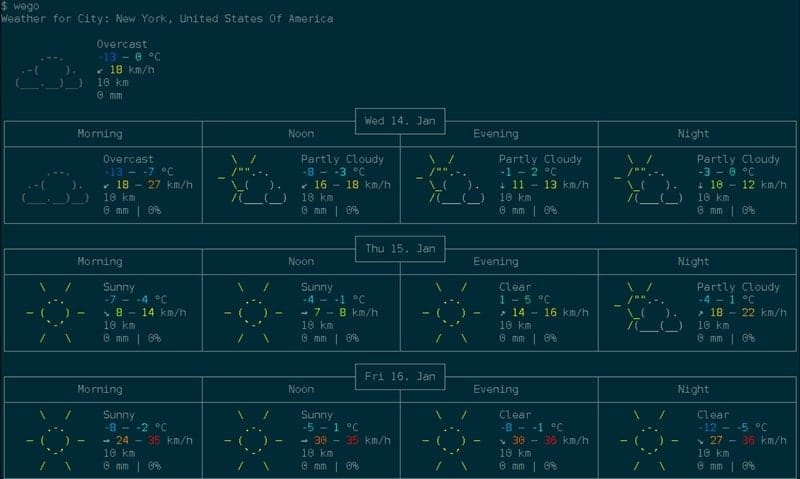
Key Features of WeGo
- The icons are beautifully generated with ASCII characters.
- You can edit the config file for setting up your custom
location via the terminal. - It can show temperature, wind speed, precipitation, and other
common parameters. - You can choose the maximum days for fetching future
forecasts. - This tool is not resource-intensive.
9. GNOME Weather
GNOME Weather is the default weather app for the Ubuntu distro
that runs the GNOME desktop environment. It comes preinstalled with
the Ubuntu. Although you can download this from the official
repository on any Ubuntu-based distribution. It is completely
compatible with any Linux distribution.
The user interface is very neatly organized. There is a subtle
GNOME vibe in the design language. It can highlight the current
weather condition with a nice background photo that describes
the weather.
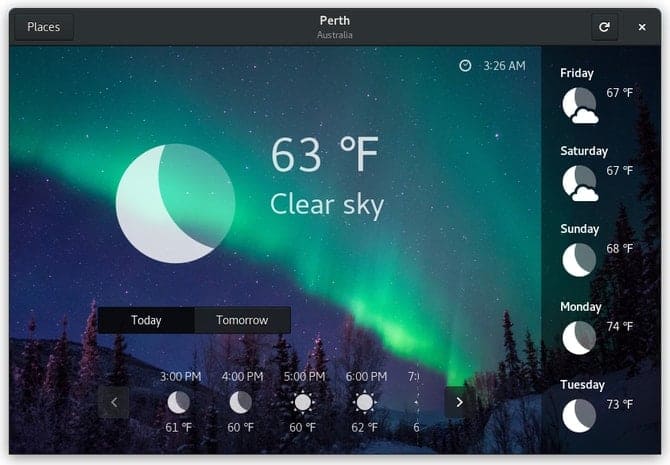
Key Features of GNOME Weather
- This tool uses the libgweather as the backend framework.
- It can display the weather condition through the notification
panel. - By default, you will get the 5 days forecast right on to the
home screen. - You can set up custom places by clicking the designated
button. - You can choose the weather data provider from a variety of
options.
10. curl Wttr.in
This is yet another terminal-based weather tool for Linux. What
I like most about the terminal-based tools is that they do not take
up unnecessary computer resources. Besides, you can get
distraction-free information just by typing a simple line of
command.
curl Wttr.in is a feature-packed tool. It shows all the
necessary information in a tabular format. The developer used some
ASCII pictures to show the weather condition. You don’t even need
to set up a particular location. You can get the location of any
city whenever you want.
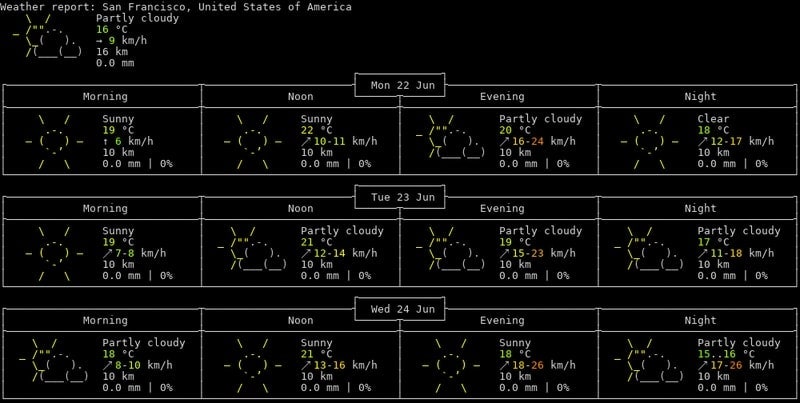
Key Features of curl Wttr.in
- It shows three days forecast with the individual periodic
conditions of the morning, noon, evening, and night. - It can detect your location automatically. If that is not
accurate, you can use modifiers in the command line to get the
updates of your city. - This tool can show wind speed, precipitation, humidity,
etc. - The raw data are neatly arranged so that you get what you need
by taking a glance. - It has a desktop weather widget support for keeping you up to
date.
Final Thoughts
There are many great weather tools apart from the above list.
Most of them have similar features. I think they won’t provide you
any exclusive value. If you want to get the most out of the
forecasting service, the above tools will be plenty. But, if you
still think that your favorite tool is missing in this list and you
want to let others know. Comment below the tool’s name with some
features that you like most about that tool. That will be helpful
for many users in search of great weather tools for Linux.
References
- ^
Best
Linux Distro: Top 10 Recommendation To Boost Up Your Linux
Experience (www.ubuntupit.com) - ^
Download
(www.weewx.com) - ^
The 20
Best Python Tips and Tricks You Must Know in 2020
(www.ubuntupit.com) - ^
Download
(github.com) - ^
Download
(github.com) - ^
Download
(github.com) - ^
19 Best
Gnome Shell Extensions For Your Ubuntu Gnome Desktop
(www.ubuntupit.com) - ^
Download
(extensions.gnome.org) - ^
Download
(github.com) - ^
Download
(github.com) - ^
Download
(github.com) - ^
Download
(wiki.gnome.org) - ^
Download
(github.com)
Read more https://www.ubuntupit.com/best-weather-tools-for-linux/